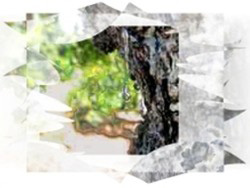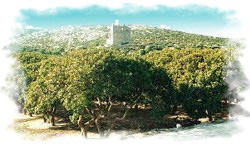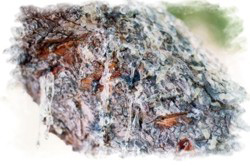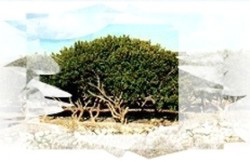The beautiful island of Chios is the only place in the world that produces mastic. Historical sources report that since the first century a.D. Mastic was cultivated in Chios and was used as a medicine. On 2nd century a.D. Galinos believed that: "Mastic elevates the conditions of blood, cures the long-time cough, bronchitis and the spitting of blood.  Mastic is used for the treatment of snakebites, scabies, stomach-ache and pain of the intestines, and cures baldness as well". On the 4th century a.D. Markellos Empeirikos reports: "Mastic is a medicine that cures the pains of stomach and urinary bladder". On 7th century a.D. Pavlos Eginitis claims that: "Mastic has therapeutic attributes for stomach, the intestines and the liver". Mastic is used for the treatment of snakebites, scabies, stomach-ache and pain of the intestines, and cures baldness as well". On the 4th century a.D. Markellos Empeirikos reports: "Mastic is a medicine that cures the pains of stomach and urinary bladder". On 7th century a.D. Pavlos Eginitis claims that: "Mastic has therapeutic attributes for stomach, the intestines and the liver".
Chios and mastic are bound together. According to some studies, the name Chios results from the Phoenician word that means mastic. According to others the word mastic, results from the verb 'mastichao' or word 'masso', while other people believe that it's the word mastix that means whip, the Chians used lasses to acquire mastic from the mastic trees.
The Romans on 250 a.D.  wanted to force Saint Isidoros to change his faith. In an effort to escape them, he resorted to Southern Chios where they found him. Seeing them approaching him, he asked God to help him and then the trees lowered their branches to hide him. But this didn't save him from the Romans, who captured him, tortured him and finally decapitated him. The martyrdom of Saint Isidoro made the mastic trees to cry perfuming teardrops. This teardrop is the mastic. wanted to force Saint Isidoros to change his faith. In an effort to escape them, he resorted to Southern Chios where they found him. Seeing them approaching him, he asked God to help him and then the trees lowered their branches to hide him. But this didn't save him from the Romans, who captured him, tortured him and finally decapitated him. The martyrdom of Saint Isidoro made the mastic trees to cry perfuming teardrops. This teardrop is the mastic.
The mastic helped also Chios during the Ottoman rule. The island had special privileges that helped Chios in the commercial area, economic area and the social life in Chios was not effected to much.
The mastic tree  that produces the mastic is called schinos (pistacia lentiscus). Mastic tree is evergreen and lives more than a hundred years, while the tree's height does not exceed two or three metres. It has long branches that lean and podgy trunk. Mastic trees proliferate with slips. that produces the mastic is called schinos (pistacia lentiscus). Mastic tree is evergreen and lives more than a hundred years, while the tree's height does not exceed two or three metres. It has long branches that lean and podgy trunk. Mastic trees proliferate with slips.
Mastic tree flourishes even in regions with barren ground. However, in grounds with limestone and good draining, mastic tree lives more years than in barren grounds. Mastic trees can grow in various places of the world. But mastic trees that shed tears of mastic are found only in Chios and more specifically in the southern region of the island, these villages are called Mastichochoria. Scientists believe that this happens because of submarine volcanos and the climate of the region. We must note that in Chios, the temperature rarely falls under 0°C  during winter. In 1850 the temperature fell in January at -5°C and destroyed most mastic trees. Mastic tree is influenced from very high temperature too. In 1987, 45°C in July caused significant reduction of production. A third factor that affects the production of mastic is dry climate. Years with extended period of drought, the production was decreased. during winter. In 1850 the temperature fell in January at -5°C and destroyed most mastic trees. Mastic tree is influenced from very high temperature too. In 1987, 45°C in July caused significant reduction of production. A third factor that affects the production of mastic is dry climate. Years with extended period of drought, the production was decreased.
The mastic producer must take care of mastic trees' health. Every year he must remove any dry branches, fertilize and plough the ground and every five years he must lop the trees. Mastic is produced mostly during the summer months and if the weather is good production can be extended until October.  In the middle of June mastic producers engrave with sharp tools the trunke of tree and the resin exudes in drops. Before doing so, they must clean the space below the tree, level the ground and cover it with white soil that is abundant in regions of southern Chios. Mastic drips on the white soil and is gathered by the mastic producers. There are three categories of mastic: pitta, fine and coarse. In the middle of June mastic producers engrave with sharp tools the trunke of tree and the resin exudes in drops. Before doing so, they must clean the space below the tree, level the ground and cover it with white soil that is abundant in regions of southern Chios. Mastic drips on the white soil and is gathered by the mastic producers. There are three categories of mastic: pitta, fine and coarse.
Mastic is used in ointments that cure burns, eczemas, frostbites and other dermatoses. Scientists believe that the absorbs cholesterol and helps in fighting hypertension, in the reduction of triglycerides, and also has antiseptic character.  Another use of mastic is the production of liqueur and ouzo. We use mastic in sweets, biscuits and cakes, as well as our old-time favourite "submarine", a sweet that was served in a glass of water. Another use of mastic is the production of liqueur and ouzo. We use mastic in sweets, biscuits and cakes, as well as our old-time favourite "submarine", a sweet that was served in a glass of water.
In Cyprus and also in many Arabic countries mastic is added in bread. While elsewhere mastic is also used in cheese production. On holy texts of Arabs there are reports about the mastic and that's the reason why Arabs consider mastic as a sign of wealth.
Chrysostomos Ganiaris has written:
Mastic tree, my first tyrant and friend
give me your wealth and your power.
All day long I used to hurt your body,
but now I am gone and you still keep. |